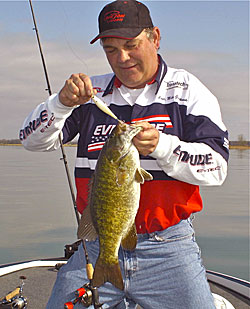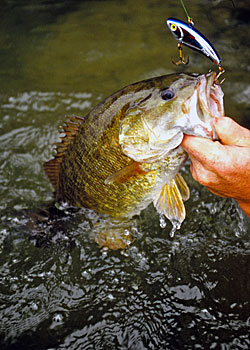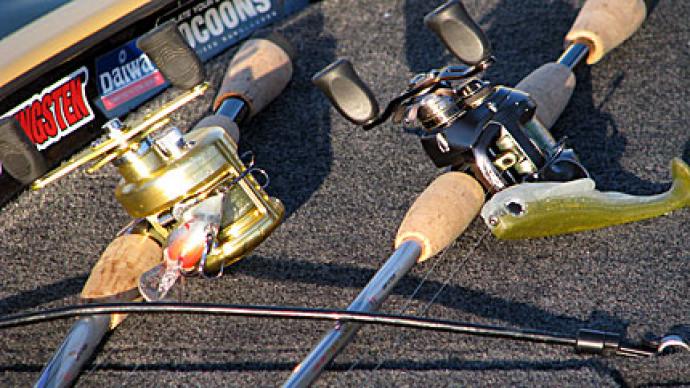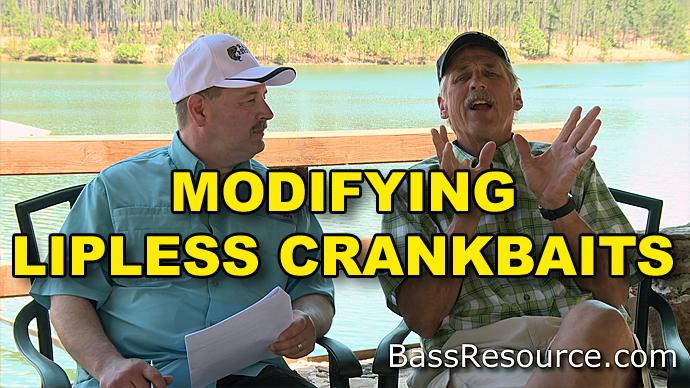
Crankbaits are an extremely versatile tool for catching bass. They can be fished shallow, deep, and anywhere in between. Picking the correct crankbait for the job is critical but not rocket science.
Joe Balog of Millennium Promotions, Inc has fished hundreds of bass tournaments across the county and confides that crankbaits are one of his go-to lures regardless of the destination.
“I’m kind of a student of crankbaits,” shared Balog. “I’ve been fishing them for as long as I can remember. The lip of the crankbait has a lot to do with how it will perform. You need to consider four things when looking at the lip of a crankbait and determining how it will function - length, width, angle, and configuration.”
“The shape, length of the lip, and where it comes out of the body largely determines the performance and action of a crankbait. Essentially, there are three types of lip designs. There’s the long lip that dives deep, a short square bill that excels for shallow presentations, and the old coffin bill that’s somewhere in between. The coffin bill was popular back in the ’80s and ’90s. Plus, the classic Rat-L-Trap style lipless crankbait has no lip at all,” said Balog.
Where the lip is positioned determines how deep the crankbait will dive. You’d think that a crankbait that has the lip at a sharp angle would dive the deepest, but that’s not true, according to Balog. “A lure that has the lip coming straight off the front of the lure is going to dive the deepest,” said Balog. Balog cited Strike King’s 6XD –10 XD and the Bandit Lure’s Ledge 250 and Fat-Free Shad BD7F as good examples. “With the right line, you’re going to be able to get down 15 to 20 feet or more because of the angle of the lip.”
Crankbaits that have long, thin lips are the deepest divers. Extended, narrow deep-diving crankbaits will also produce a tighter shimmy versus a wobble. “The Shad Rap is a classic example of a crankbait with a longer lip that produces that tighter wiggle,” offered Balog. “It produces a tight shudder movement because of the slender body and longer lip. Movement like that is exactly what you want in cold water.”
Square-billed crankbaits became popular in the early 1970’1970s the Big O and other alphabet baits produced by Bagley and Bill Norman. The lures were a big secret on the B.A.S.S. tour until anglers won a few tournaments with them, and the cat was out of the bag. Example of today’s square-billed cranks includes the Lucky Craft RC1.5, Strike King’s KVD 1.5, and the Bomber Square A.

The square bill was unique because it could be fished anywhere you’d fish a spinner bait. If you’re not banging and bumping junk with the bait, you’re not fishing it right. Legendary angler Rick Clunn once said, “If you’re afraid of getting snagged, you’ll never be a square-bill fisherman.” Getting two feet from a bank doesn’t get it. You need to throw right on the bank to take advantage of the triggering power of a square bill.
The design of the square bill makes the bait stand up on its nose. The angle inhibits the hooks from getting snagged. Proponents of the square bill are skilled in the art of deflection. The bait is designed to bounce off rocks, limbs, stumps, and pilings to trigger reaction strikes. The square bill excels in water less than four feet deep. You want to burn the bait in clear water and have it banging the cover. You want to slow the retrieve in murky water so the bass can find it. Because of the lure’s design, it will bounce and roll, usually without getting hung up. That hesitation or delay is what triggers strikes. The heavy line is a prerequisite when using square bills to pull hooks free of snags.
Some of the original and best square-billed cranks are made of wood. Baits made of wood provide a unique action that can’t be duplicated but also produces some inherent problems. Wood is not as durable as plastic, and when you’re intentionally banging the lure off every rock, dock, and log you can find, wood lures do not hold up well. Wood lures also don’t run as consistently as lures made from plastic. You might have one out of a half dozen with just the right action, but it won't last long if you’re fishing it right.
Like the Bandit Flat Maxx, Coffin-billed crankbaits are like a square bill on steroids. The coffin bills are an example of a lure with the same characteristics as a square bill, but it can dive deeper, usually between 7 and 13 feet. Like the square bill, the coffin bill is adept at bouncing off wood, rocks, and docks. The angular bill causes the lure to scoot off to the side or careen upwards for an instant after contact before resuming its wiggling course. It’s a serious trigger for predators. Coffin bills generally produce a tighter wiggle than a square-billed lure. They also are not quite as snag-free as the pudgy square bill.

“I’m not a big rattle guy,” said Balog.” The fish can hear the bait regardless because of the hooks banging around, the split rings, etc. I don’t think any fish hears a crankbait from a long way away due to the rattle and rushes over to find the lure if they can’t see it. However, I fish clear water a lot, so maybe I’m partial.”
As for lipless cranks (Rat-L-Traps, etc.) Balog feels rattles are necessary. “They make a few of these lures without rattles, and I’ve tried them without much luck. I think rattles are important there.”
Lipless crankbaits are in a category all of their own. While they belong in any crankbait discussion, they’re an oddball when it comes to crankbait lips because they don’t have one. The head of the lure serves as the lip. Known for their extreme vibration, classic lipless crankbaits include Bill Norman’s legendary Rat-L-Trap, Cotton Cordell’s Super Spot, and the Booyah One Knocker.
Many bass anglers turn to lipless crankbaits when all else fails because they’re incredibly versatile and easy to fish. Lipless rattlers can be burned back under the surface or allowed to sink to a given depth and retrieved while pumping and ripping it back. You can bang them off rocks, rip them through vegetation, bounce them off docks or jig them in clear water. There may not be a more versatile crankbait.
Lure designers keep playing and tweaking lip configurations. A good example is Rapala’s Scatter Rap design. The cupped-lip design causes the lure to dart off to one side or the other on the retrieve. There’s no need to impart any action because the lure behaves erratically on its own. The Scatter Rap series is available in minnow, shad, crankbait, and countdown options, allowing you to probe depths from 4 to 10 feet.
When choosing a crankbait, it’s best to find one that produces a rectangular dive curve versus a pendulum. The quicker a crankbait reaches its maximum depth and maintains it, the better. It means more time in the strike zone.
“As a general rule, you’re going to want to use the thicker, heavier line when fishing crankbaits in the shallows,” advised Balog. “Thinner line will help you achieve greater depths with deep divers. However, using deep divers in open water puts more stress on the line than you realize. I would recommend a minimum of 10-pound fluorocarbon when using deep divers. Generally, go as light as you can, considering the cover.” Braid shines when ripping grass or banging stumps.
BassResource may receive a portion of revenues if you make a purchase using a link above.




